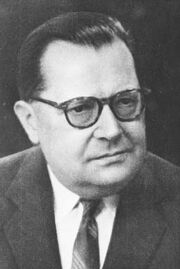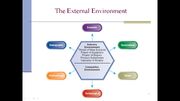
Karl Ludwig von Bertalanffy
Organizational Environments
Systems Theory
Authors: Karl Ludwig von Bertalanffy and Kenneth Berrien
Systems theory originates from early research by Bertalanffy and Berrien. Systems theory in organizational environments asserts that institutions have an interdependent relationship with the external environment (Bess and Dee, 2012). Ongoing transactions occur on a continuous basis between the organization and the environment. Key characteristics of the environment sustain the organization. Under this theory, a reciprocal relationship exists between the organization and the environment.
References
Berrien, F. K. (1968). General and social systems theory. New Brunswick, NJ: Rutgers University Press.
Bertalanffy Center for the Study of Systems Science. (2012). News and events. Retrieved from http://www.bertalanffy.org/
Bertalanffy, L. von. (1968). General systems theory. New York: Braziller.
Bess, J.L. & Dee, J.R. (2012). Understanding college and university organization: Theories for effective policy and practice (2 vol). Sterling, VA: Stylus.
Rosenberg, L. (2008). Understanding college and university organization: theories for effective policy and practice—volume II: Dynamics of the system. Strategic Enrollment Management: Newsletter of the American Association of Collegiate Registrars and Admisisons Officers. Retrieved from http://www2.aacrao.org/sem/index.cfm?fa=view&id=4023
Population Ecology Theory
Authors: Michael T. Hannan and John Freeman
According to population ecology theory, organizations that adapt to their environments are more likely to succeed. Population ecology theory states that the environment is ever changing and asserts that organizations are compelled to respond to changes in the environment (Bess and Dee, 2012). Population ecology theory addresses competition and the degree to which an organization can adapt to the environment. Higher education institutions are inclined to operate best in an environmental niche that provides resources for survival. Hannan & Freeman (1977) note that organizations that are able to maintain an optimum fit with the external environment are most likely to survive in changing environments.
Click here for more information on Population ecology.
References
Bess, J.L. & Dee, J.R. (2012). Understanding college and university organization: Theories for effective policy and practice (2 vol). Sterling, VA: Stylus.
Betton, J. & Dess, G.G. (1985). The application of population ecology models to the study of organizations. Academy of Management Review, 10(4), 750-757.
Hannan, M.T. & Freeman, J. (1977). The population ecology of organizations. American Journal of Sociology, 82(5), 929-964.
Noy, E. (2010). Niche strategy: merging economic and marketing theories with population ecology arguments. Journal of Strategic Marketing, 18(1), 77-86.
Institutional Theory
Authors: Paul J. DiMaggio and Walter W. Powell
Institutional theory addresses the significance of understanding external expectations for institutions (Bess and Dee, 2012). According to DiMaggio and Powell (1983), colleges and universities gain legitimacy through coercive, mimetic, and normative conformity. Choices made by the institution are limited by external pressures from the environment. Institutional theory explains that institutions reflect the attitudes, values, and beliefs of the external environment in which the institution is embedded (Bess and Dee, 2012).

The External Environment
References
Bess, J.L. & Dee, J.R. (2012). Understanding college and university organization: Theories for effective policy and practice (2 vol). Sterling, VA: Stylus.
DiMaggio, P. J. & Powell, W. W. (1983). The iron cage revisited: Institutional isomorphism and collective rationality in organizational fields. American Sociological Review, 48. 147-160.
Random Transformation Model
Authors: James G. March and Johan P. Olsen
The random transformation model proposes that no fundamental relationship exists between the organization and the environment (March and Olsen, 1976). The success rate of the organization occurs mainly by chance. No casual relationship between the environment and the organization can explain the continuity of an organization over a period of time (Bess and Dee, 2012). Changes in both the environment and the organization occur by chance.
References
Bess, J.L. & Dee, J.R. (2012). Understanding college and university organization: Theories for effective policy and practice (2 vol). Sterling, VA: Stylus.
March, J. G., & Olsen, J.P. (1976). Ambiguity and choice in organizations. Bergen, Norway: Universitiesforlaget.
March, J.G. & Olsen, J.P. (1984). The new institutionalism: organizational factors in political life. The American Political Science Review, 78(3), 734-749.
Contingency Theory
Authors: Tom Burns and G.M. Stalker
Contingency theory asserts that organizations can only be successful when organizational variables are strategically aligned with environmental conditions (Bess and Dee, 2012). The organization must be flexible in order to react to external conditions of the environment. Burns and Stalker (1961) offer the following table to explain the fit between the organizational variables and environmental conditions. According to contingency theory, the closer the environment is related to the organizational design the more effective the organization will be overall.
Burns and Stalker’s Contingency Theory
|
Environmental Conditions |
Appropriate Organizational Design |
|
Stable, low rate of change |
Mechanistic |
|
Dynamic, high rate of change |
Organic |
*Table adapted from Bess and Dee (2012)
Click here for more information on Contingency theory.
References
Bess, J.L. & Dee, J.R. (2012). Understanding college and university organization: Theories for effective policy and practice (2 vol). Sterling, VA: Stylus.
Burns, T. , & Stalker, G. (1961). The management of innovation. London: Tavistock.
Ketokivi, M. (2006). Elaborating the contingency theory of organizations the case of manufacturing flexibility strategies. Production and Operations Management, 15(2), 215-228.
Resource Dependence Theory
Authors: Jeffrey Pfeffer and Gerald Salancik
Resource dependence theory states that institutions are dependent on external entities in order to survive (Bess and Dee, 2012). External constituents not only determine whether or not an organization will receive resources but they also determine the extent to which the organization uses the resources. Resource dependence theory implies that there is a power relationship between the organization and external entities. In addition to adapting to the environment organizations must maintain strong external relationships with constituents to attain resources for stability. Bess and Dee (2012) offer the following table for managing resource dependence:
|
Dependency-Reduction |
|
|
External Linkages |
|
|
Enactment of a New Environment |
|
References
Bess, J.L. & Dee, J.R. (2012). Understanding college and university organization: Theories for effective policy and practice (2 vol). Sterling, VA: Stylus.
Casciaro, T. & Piskorski, M. J. (2005). Power imbalance, mutual dependence and constraint absorption: a closer look at resource dependence theory. Administrative Science Quarterly, 50(2), 167-199.
Pfeffer, J. & Salancik, G. (1978). The external control of organizations: a resource dependence perspective. New York: Harper & Row.
Social Construction Perspectives
Authors: Stanley Deetz, Mary Hatch, Dennis Mumby, and Karl Weick
Social constructionist perspectives on environment assert that the external environmental conditions are not tangible and are unable to be analyzed objectively (Bess and Dee, 2012). Instead, the environment is made up of cognitive and communicative process performed by organizational members. Organizational members reflect the values, beliefs, and ideologies of the external environment. The manner in which organizational members interpret the environment is called sensemaking (Weick, 1995). Identity and image both play a major role is the social constructionist perspective of organizational environments. Identity refers to the impression institutional members have on the organization, while image defines how external constituents view the institution.
References
Bess, J.L. & Dee, J.R. (2012). Understanding college and university organization: Theories for effective policy and practice (2 vol). Sterling, VA: Stylus.
Deetz, S. (1992). Democracy in an age of corporate colonization: Development in communication and the politics of everyday life. Albany State University of New York Press.
Hatch, M. (1997). Organization theory: Modern, symbolic, and postmodern perspectives. New York: Oxford University Press.
Hatch, M. & Schultz, M. (1997). Relations between organizational culture, identity and image. European Journal of Marketing, 31(5/6), 356-365.
Mumby, D. (1996). Feminism, postmodernism, and organizational communication studies: a critical reading. Management Communication Quarterly, 9(3), 259-295.
Weick, K. (1995). Sensemaking in organizations. Thousand Oaks, CA: Sage.
Postmodern Perspectives
Authors: Charles Darwin and Max Weber
Postmodern perspectives on organizational environments suggest that positivist and social constructionist perspectives are problematic. Predictions and the ability to control are not practical environments that are chaotic. Furthermore, power differences within the organization complicate sensemaking and image. Chaos theory suggests that organizations should make sense of chaotic events and make long-term plans around such events as opposed to adjusting to each change in the external environment (Bess and Dee, 2012). Chaos theory implies that change can occur in a nonlinear fashion, thus creating a butterfly effect in which the smallest change in conditions has the potential to magnify outcomes.
Click here for more information on Chaos theory.
References
Bess, J.L. & Dee, J.R. (2012). Understanding college and university organization: Theories for effective policy and practice (2 vol). Sterling, VA: Stylus.
Forgues, B. & Thiétart, R.A. (1995). Chaos theory and organization. Organization Science, 6(1), 19-31.
Lorenz, E. (1993). The essence of chaos. Seattle: University of Washington Press.
Smith, W. (2001). Chaos theory and postmodern organization. International Journal of Organization Theory & Behavior, 4(3/4), 259-286.